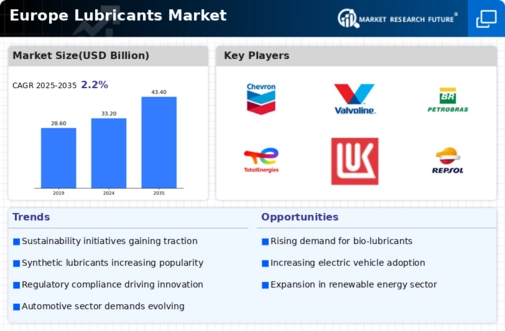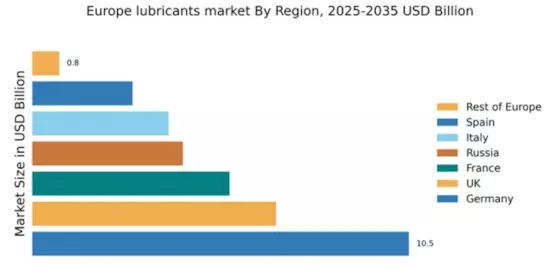Technological Advancements in Lubricants
The lubricants market in Europe is experiencing a notable shift due to rapid technological advancements. Innovations in formulation and production processes are enhancing the performance and efficiency of lubricants. For instance, the introduction of synthetic lubricants has led to improved thermal stability and reduced friction, which are critical for high-performance applications. The market is projected to grow at a CAGR of approximately 4.5% from 2025 to 2030, driven by these advancements. Furthermore, the integration of nanotechnology in lubricant formulations is expected to enhance their properties, making them more effective in various industrial applications. This trend indicates a strong potential for growth in the lubricants market, as manufacturers strive to meet the evolving demands of consumers and industries alike.
Increased Focus on Supply Chain Resilience
The lubricants market in Europe is currently experiencing an increased focus on supply chain resilience. Recent disruptions have highlighted the vulnerabilities within supply chains, prompting companies to reassess their sourcing and distribution strategies. As a result, manufacturers are investing in local production facilities and diversifying their supplier base to mitigate risks associated with global supply chains. This trend is likely to enhance the stability of lubricant supply, ensuring that companies can meet the growing demand without significant delays. Furthermore, the emphasis on local sourcing may lead to a rise in the production of regionally tailored lubricants, which could cater more effectively to the specific needs of European industries. This strategic shift is expected to bolster the lubricants market, fostering a more robust and responsive supply chain.
Growth of Automotive and Industrial Sectors
The lubricants market in Europe is closely tied to the growth of the automotive and industrial sectors. As the automotive industry continues to evolve, particularly with the rise of electric vehicles (EVs), there is a growing demand for specialized lubricants that cater to new technologies. The automotive sector is projected to account for approximately 40% of the total lubricant consumption in Europe by 2026. Additionally, the industrial sector, encompassing manufacturing and machinery, is also witnessing increased lubricant usage due to the need for enhanced operational efficiency. This growth in both sectors is likely to propel the lubricants market, as companies seek to optimize performance and reduce maintenance costs through advanced lubricant solutions.
Rising Demand for High-Performance Lubricants
The lubricants market in Europe is witnessing a rising demand for high-performance lubricants, driven by the need for enhanced efficiency and reliability in various applications. Industries such as automotive, aerospace, and manufacturing are increasingly adopting advanced lubricants that offer superior protection and performance under extreme conditions. This trend is reflected in the growing market share of synthetic and semi-synthetic lubricants, which are favored for their ability to withstand higher temperatures and pressures. It is anticipated that high-performance lubricants will capture a larger portion of the market, potentially reaching 30% by 2027. This shift indicates a broader trend towards performance-oriented products, which could reshape the competitive landscape of the lubricants market in Europe.
Regulatory Compliance and Environmental Standards
In Europe, stringent regulatory frameworks and environmental standards are significantly influencing the lubricants market. The European Union has implemented various regulations aimed at reducing emissions and promoting the use of environmentally friendly products. As a result, lubricant manufacturers are compelled to innovate and develop products that comply with these regulations. The market for bio-based and biodegradable lubricants is expanding, as these products align with the EU's sustainability goals. It is estimated that the demand for eco-friendly lubricants could increase by 20% over the next five years, reflecting a shift towards greener alternatives. This regulatory landscape not only drives innovation but also creates opportunities for companies that prioritize sustainability in their product offerings.


















Leave a Comment